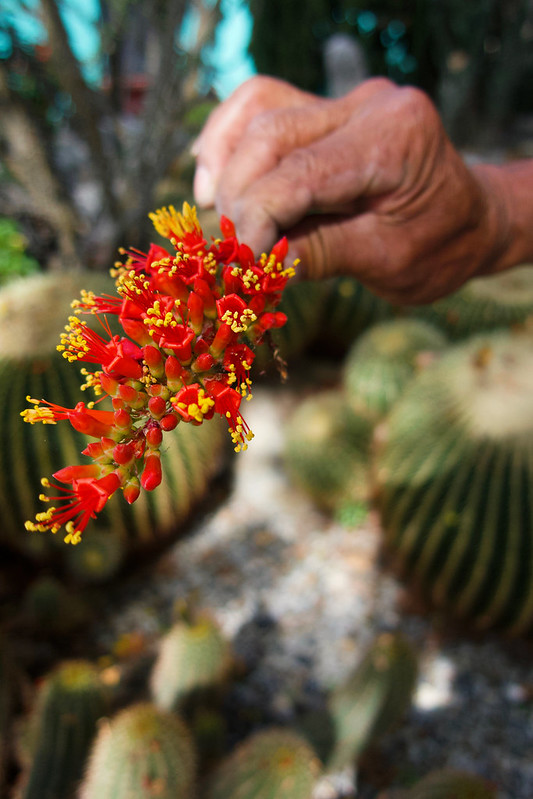It started off mid-Saturday morning May 1 at Ray and Netty’s plant sale at their home in Atwater Village. There in the driveway was a 3-gallon plant beckoning me with the intriguing tag “mystery euphorbia.” Ray Valentine really knows how to get a plant collector’s attention.
I was on the hunt for textural drama for pots. And with that agenda in mind, it was a very good day!
Here’s one of the mystery euphorbias I brought home, cuttings from the tree pictured in the top photo, potted up and placed on a high stool to keep it out of the reach of an inquisitive puppy. I’ve no intention of letting it grow to tree size in the ground. As far as identification, Euphorbia drupifera seems the closest fit I’ve found so far. The plant has a pachypodium vibe, with thorny stems ending in lush leaves at the tips. Netty said it is extremely cold sensitive and will drop all its leaves when cold-challenged. E. drupifera is a Zone 11 plant, so that fits the description as well.
Another mystery euphorbia from the Valentines’ sale, one I’ve yet to identify. I was attracted to the rhipsalis-like habit of growth, hoping for another lush-appearing but dry-tolerant plant to spill out of a hanging pot. Then Netty showed me the mother plant — another enormous tree! Still, in the short term, I’ll probably grow it from a hanging pot to drape over the sides.
In the Valentines’ back garden the size of the specimen plants seems even larger now that they have cleared out most of the smaller understory succulents for ease of maintenance. All the Aloe camperi I was recently enthusing about in the front garden have been likewise cleared out and the parkway graveled over. Netty said the debris on the succulents was becoming too much maintenance, and I admitted that I took out the succulents under the Pearl Acacia in my front garden for the same reason. We both agreed that trees are priority number one, for shade, for cooling, for cleansing the air, for wildlife.
These huge specimens were the source of the plants available at the sale.
After the Valentines’ sale, I made a quick stop at Potted, about fives minutes from the Valentines, for a yellow pot, then headed to Worldwide Exotics in Lakeview Terrace, which is now only open on Saturdays. There were many mystery plants here too, which is no surprise since the nursery was started by plant explorer Gary Hammer, who passed away 10 years ago. At these extensive growing grounds, the plants are unlabeled. After you make your selections, you bring your swag to Shelley Jennings for ID and payment. Shelley consults her three-ring binder and provides names for all selections, like this Homalocladium platycladum, Ribbon Bush. The Ribbon Bush too has potential to become a large shrub, but it’ll stay in a pot for the short term.
And at Worldwide Exotics I found this treasure, which Shelley identified as Hechtia tillandsiodes, a barbless hechtia! Swoon….
I flagged down Shelley’s husband Ken after seeing this medusa-like, oddball bromeliad and asked if there were any small plants for sale. He pointed to a group of four hanging just behind me.
Silvery slim leaves spill forth studded with nubby blooms that give it the common name Pinecone Bromeliad, Acanthostachys strobilacea.
However, this fern needed no introduction. Pyrrosia lingua is epiphytic, so rather than plant it in a very crowded garden where it would be swamped, I used an old orchid box which I lined with some beech bark that I peeled off some firewood, mossed the gaps, and hung it on the east patio (Pandemic Garden Project.)
I’ll get around to more photos of WE’s growing grounds later this week. Just an incredibly fun place for a good plant prowl.






















WOW!!!! So much to drool over here. First of all I thought rhipsalis too, when first seeing that interesting euphorbia. And that garden! (where the sale was)… how fabulous. I will now be lusting after Pinecone Bromeliad, Acanthostachys strobilacea. And why have I never grown any of my (many) pyrrosia as epiphytes? I must start!
I have the same thought as Loree—I had no idea Pyrrosia is an epiphyte!
You’re an urban plant explorer! The size of many of the plants in the Valentines’ garden was startling to say the least but I’m not at all surprised that you took some of those same plants home 😉 I have a ribbon bush in my garden (although I purchased it under another of its identities: tapeworm bush). It’s in a relatively dry spot in partial shade. It took a hit from last year’s heat (and the lack of rain this year didn’t help) but it’s still alive, if also still small.
Awesome garden there–the age of it makes it exceptional in a town where everything seems to get remodeled over and over again.
Way cool plants, too. Good gets!
@Loree, if you want a Pinecone bromeliad I’ll grab one on a return visit. Prices are very good, around $10.
@Heather, the fact it’s epiphytic is probably more important to zone 10 gardens than PNW gardens! Such survival techniques are a boon in this dry climate!
@Kris, you have a ribbon bush! It can supposedly grow to 10 feet in the Bay Area. Yeah, that common name is yuck, so I omitted it 😉
@Hoov, the garden is a gem, and the owners were debating building an ADU in the garden for an aging parent, but the parent refused to come, so the garden stays!
Yes please!!! I would LOVE a Pinecone bromeliad!
@Loree, stay tuned and fingers crossed!